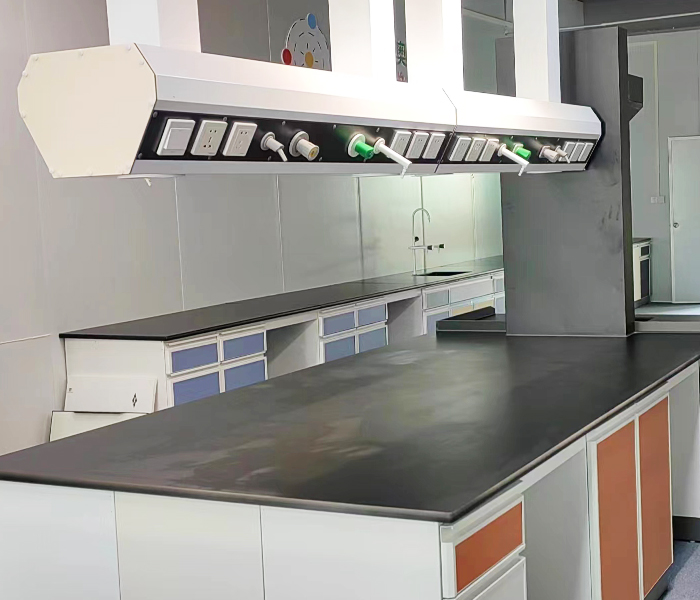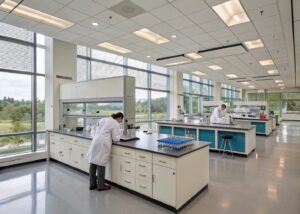Table of Contents
In today’s fast-evolving scientific landscape, the rise of hybrid laboratories is transforming the way research environments are designed. With fields like chemistry, biology, and physics often converging into a single space, the demand for versatile lab furniture that accommodates these multidisciplinary needs has surged. Researchers need lab spaces that offer flexibility, adaptability, and efficiency to keep up with modern innovations. This article delves into how hybrid lab furniture is adapting to support these diverse, ever-changing environments and how it’s helping labs streamline workflows across multiple disciplines.
The Growing Trend of Multidisciplinary Labs
Hybrid labs, also known as multidisciplinary labs, are quickly becoming the new norm in research environments. These spaces blend different scientific fields, from molecular biology to materials science, all under one roof. By combining chemistry, biology, physics, and sometimes even engineering or computational research, hybrid labs foster collaboration and innovation like never before.
This growing trend is largely driven by the need for cross-disciplinary research. In many cutting-edge scientific fields, breakthroughs often occur at the intersection of multiple disciplines, requiring researchers to work together on shared projects. To facilitate this, labs are adopting a multidisciplinary lab design that promotes flexibility, making it easier for teams to shift between different experiments or functions.
Furniture That Supports Diverse Functions
To keep pace with the demands of hybrid labs, the furniture must evolve accordingly. Traditional lab designs typically cater to one primary function, but hybrid labs need adaptable lab furniture that can support multiple scientific workflows simultaneously. This means introducing:
- Adjustable Benches: These workbenches can be height-adjusted for seated or standing tasks, making them useful for both meticulous chemistry work or large-scale physics experiments. Researchers can easily customize the benches to fit their task at hand.
- Movable Storage: With projects changing frequently, having storage that is mobile and can be repositioned as needed is critical. Movable storage units can easily shift to create more space for larger equipment or be used to divide areas for different research groups.
- Modular Systems: Modular furniture systems allow components to be rearranged or expanded over time, meaning a laboratory can be reconfigured without major renovations. Whether the lab grows or shifts its focus, the furniture can adapt seamlessly.
This versatile lab furniture enables scientists from multiple fields to work in the same space without having to disrupt the workflow of others, making the lab more efficient and reducing downtime between projects.
Adapting Furniture to Serve Multiple Roles and Teams
The beauty of hybrid labs lies in their ability to serve different research teams with various needs. This can be a challenge for furniture design, but it’s one that adaptable furniture addresses. Hybrid lab furniture isn’t just about fitting into the current layout but being flexible enough to evolve alongside the research conducted in the space.
For instance, laboratories might use lab tables with integrated power sources and adjustable shelving. These tables can support tasks like microscopic observation in the morning and mechanical testing in the afternoon, ensuring that researchers from different disciplines have what they need. Hybrid labs may also include mobile fume hoods that can be wheeled into place, providing safety for chemical reactions in one part of the lab while being out of the way when not in use.
By providing the flexibility to accommodate different teams with various projects, adaptable furniture allows for smoother transitions between experiments, increasing the overall productivity of the lab. Lab managers and designers must look for furniture solutions that offer this level of versatility.
Examples of Hybrid Lab Furniture Streamlining Workflows
Several laboratories across the U.S. have embraced the hybrid design approach, using adaptable furniture to streamline their workflows. Below are some examples of how hybrid lab designs are enhancing efficiency:
- Biotech-Pharma Hybrid Labs: A major pharmaceutical company has designed hybrid research labs combining biology and chemistry workflows. They’ve integrated adjustable lab benches with built-in power sources and retractable shelving that can be customized depending on the task. This has improved collaboration between their chemistry and molecular biology teams, speeding up drug discovery processes.
- University Research Centers: Many university labs are taking a hybrid approach by creating spaces where physics, chemistry, and biology students can work together. Here, modular lab furniture allows for fast reconfiguration of the space to accommodate various research projects or teaching labs. Researchers can rearrange workstations, storage, and equipment within hours, reducing downtime and enhancing collaboration.
- Materials Science Labs: In material science labs, where different experiments require both small-scale and large-scale testing, movable storage and mobile workbenches allow scientists to shift equipment and tools as needed. This adaptability reduces the need for separate rooms for different tasks, cutting down on unnecessary space and costs.
The Future of Hybrid Lab Furniture Design
As multidisciplinary labs become more common, hybrid lab furniture will continue to evolve. The key to success lies in anticipating the future needs of these spaces. Labs will require more adaptable solutions that don’t just work for today’s tasks but also for future challenges. Look for furniture that offers maximum flexibility, integrates seamlessly with lab technology, and can be easily reconfigured to keep pace with rapid scientific advancements.




